What is asparagus, what does it look like and how is it used?
Green, white and purple asparagus - a delicacy that is popular in the cuisines of different countries. The vegetable is endowed with a lot of beneficial properties due to its chemical composition. The shoots have an excellent taste and are easily digestible. Our article will help you find out more information about asparagus, the peculiarities of its cultivation and use in cooking and folk medicine.
What is asparagus
Asparagus (another name is asparagus) is a plant that produces young stems from rhizomes. There are about three hundred types of crops in nature, but not all of them are suitable for consumption. Great for proper nutrition.
Asparagus gained popularity during the reign of the Egyptian pharaohs and was considered the food of the gods. The French kings highly appreciated the taste of the product and were convinced that only representatives of blue blood were given the honor of feasting on asparagus. For a long time, peasants were forbidden to consume the fragrant stems.
In Russia, the vegetable appeared in the 18th century on the tables of noble nobles. This was not surprising, because the cost of asparagus at that time was exorbitant.
What does it look like
The upper part of the plant is young and succulent shoots of purple, green or white flowers, which are eaten. When the stems reach 15-20 cm in length, they are cut with a special long knife. The lower part of the stem is rough, so it is immediately removed before cooking.
The plant itself looks like a large fluffy bush with a well-developed rhizome.The leaves resemble small needles. Asparagus blooms with small flowers that turn into berries with seeds inside.
The photo shows what the stalks of green and white asparagus look like.

Vegetable or root vegetable
Is asparagus a vegetable or not? The answer to the question lies in the peculiarities of the growth of culture. Edible stems emerge from the plant's rhizome and subsequently grow into a bush.
Asparagus shoots are classified as vegetables, and the root vegetable is the thickened root of plants, which serves as a reservoir for the deposition of nutrients. For example, carrots, radishes, turnips, beets, parsnips, etc.
Botanical description
Asparagus is a perennial plant that belongs to the asparagus family. Young stems, as they grow, turn into shrubs with dense branches about 2 m high.
The stems are covered with needles (twigs), which make the plant fluffy. True leaves in the process of evolution turned into small scales from which full-fledged branches grow.
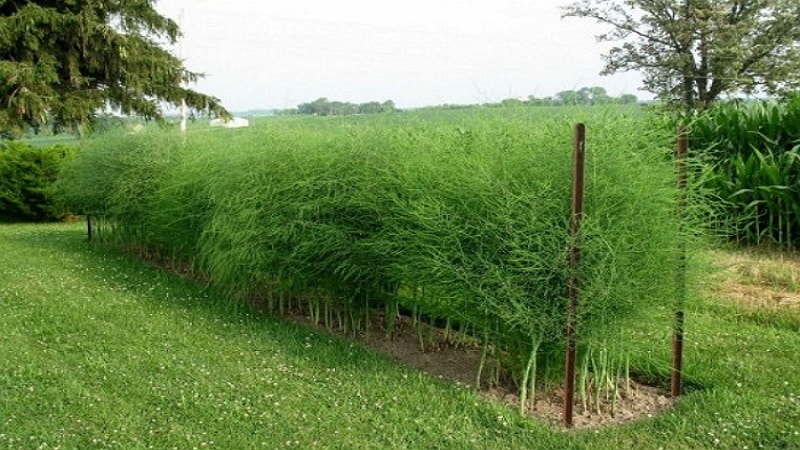 The plant has a well-developed root system. Every year a new rhizome grows on top of the old one, which dies and gradually rises above the ground surface.
The plant has a well-developed root system. Every year a new rhizome grows on top of the old one, which dies and gradually rises above the ground surface.
The bases of vegetative buds and stems are collected in the center of the rhizome. From them, in early spring, succulent white shoots appear. After being exposed to sunlight, they acquire a green tint and then become woody. They form leaves and red berries.
Asparagus is a dioecious plant with male and female flowers. Male flowers resemble yellow bells with an underdeveloped pistil and stamens in two rows. Female flowers are small, pale in color, round in shape with a developed pistil and underdeveloped stamens.
Male plants grow stronger and produce more shoots with a more rigid structure.Female plants produce smaller shoots that are much thicker in diameter and have a delicate flavor.
Reference. Asparagus grows in one place for 15-20 years. The plant is resistant to sub-zero temperatures and can withstand frosts down to -30°C.
Composition and properties
Chemical composition of plant stems (per 100 g):
- vitamin A – 83 mcg;
- beta-carotene – 0.5 mg;
- vitamin B1 (thiamine) – 0.1 mg;
- vitamin B2 (riboflavin) – 0.1 mg;
- vitamin B4 (choline) – 16 mg;
- vitamin B5 (pantothenic acid) – 0.274 mg;
- vitamin B6 (pyridoxine) – 0.091 mg;
- vitamin B9 (folate) – 52 mcg;
- vitamin C (ascorbic acid) – 20 mg;
- vitamin E (alpha tocopherol) – 2 mg;
- vitamin K (phylloquinone) – 41.6 mcg;
- vitamin PP – 1.4 mg;
- potassium – 196 mg;
- calcium – 21 mg;
- silicon – 98 mg;
- magnesium – 20 mg;
- sodium – 2 mg;
- sulfur – 22 mg;
- phosphorus – 62 mg;
- chlorine – 160 mg;
- aluminum – 80.6 mcg;
- boron – 19.1 mcg;
- vanadium – 2.6 µg;
- iron – 0.9 mg;
- iodine – 15 mcg;
- cobalt – 1.7 mcg;
- lithium – 0.4 mcg;
- manganese – 0.158 mg;
- copper – 189 mcg;
- molybdenum – 0.7 mcg;
- nickel – 0.5 mcg;
- rubidium – 28.5 mcg;
- selenium – 2.3 mcg;
- strontium – 12.9 mcg;
- fluorine – 110 mcg;
- chromium – 0.3 mcg;
- zinc – 0.54 mg.
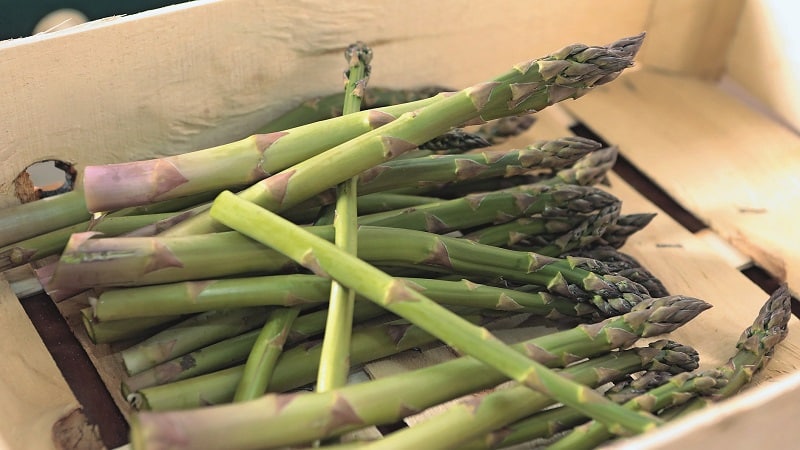
Green shoots contain more vitamins and microelements, fiber and proteins than white shoots. The heads are the most delicious and aromatic part. Sulfur is responsible for the characteristic odor.
The healing properties of asparagus are due to its chemical composition:
- diuretic effect;
- normalization of blood pressure;
- regulation of heartbeat;
- improving liver and kidney function;
- laxative effect;
- analgesic and sedative effect;
- blood purification;
- elimination of inflammation;
- stimulation of the immune system.
Benefit
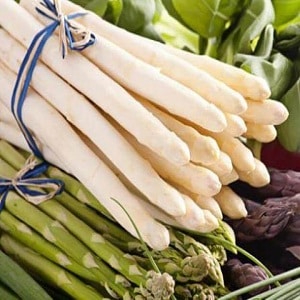 Asparagus is recommended for consumption by people suffering from diseases of the genitourinary system and kidneys. Potassium improves urine flow.
Asparagus is recommended for consumption by people suffering from diseases of the genitourinary system and kidneys. Potassium improves urine flow.
Due to the high content of folic acid, asparagus is recommended to be eaten during pregnancy and breastfeeding. Vitamin B9 reduces the risk of developing diseases of the fetal nervous system.
Asparagus has a low glycemic index and is therefore safe for diabetics.
A large number of antioxidants effectively fight malignant cells. Doctors insist on including asparagus in the diet for Alzheimer's disease.
Green shoots actively remove toxins from the body and help restore liver cells.
Asparagus has long been known as an aphrodisiac that enhances libido and male power.
Green shoots help get rid of diarrhea and other diseases of the digestive system. The product contains inulin, which is responsible for stabilizing the intestinal microflora.
Plant biologically active substances (carotene, lutein, rutin, saponins) normalize the functioning of the heart and make the walls of blood vessels elastic. Asparagus is useful for people with varicose veins.
The antibacterial and antiviral properties of the plant help restore strength during ARVI and reduce body temperature.
Low calorie content makes asparagus an ideal product for those who want to reduce body weight. Thanks to the mild diuretic and laxative effect, toxins and waste are washed out of the body.
Harm and contraindications
Asparagus provokes allergies in people intolerant to leeks, green onions and garlic.
Excessive use reduces the ability to excrete lithium. This causes aggression, thirst, tremors of the hands and muscles.
Natural plant substances saponins can irritate the walls of the stomach. Therefore, if you have an ulcer or gastritis, it is better to refrain from eating asparagus.
It is also undesirable to use asparagus as food for cystitis and rheumatism.
KBZHU
Nutritional value of the product:
- calorie content – 21 kcal;
- proteins – 1.9 g;
- fats – 0.1 g;
- carbohydrates – 3.1 g;
- organic acids – 0.1 g;
- fiber – 1.5 g;
- water – 92.7 g;
- ash – 0.6 g;
- starch – 0.9 g;
- saccharides – 2.2 g.

Types of Asparagus
White asparagus is a real delicacy that is especially popular in Europe. It ripens in early March. The shoots are collected until the end of June. To preserve the white color, the shoots are sprinkled with earth and covered with black plastic film on top, blocking access to sunlight. Growing this species is a labor-intensive process, so the price of the product is high. There are no hard fibers in the stems, and the taste is soft and reminiscent of excellent quality butter.
Green asparagus is the most common type. Previously, green shoots were rarely eaten, with preference given to white asparagus. Over time, it turned out that the product has a rich chemical composition and has a lot of useful properties.
Purple asparagus is very rarely found on sale. To obtain a rich purple color, they use a special growing technology with short sunbathing sessions. As a result, anthocyanin substances are formed in the stems, which are responsible for the blue, red and purple shades of plants. During heat treatment, asparagus turns green and acquires a bitter taste.
Sea asparagus is a unique type of asparagus that grows in coastal areas. It gained the greatest popularity in Mediterranean and Japanese cuisines. The product contains sea salt, potassium, iodine, magnesium, calcium, iron. It tastes like seaweed. Heat treatment helps remove excess salt.The product is consumed fresh and cooked.
Growing
Cultivating asparagus in the climatic conditions of Russia is not an easy task, but it is doable. The main thing is to choose unpretentious varieties. For example, Snow Head, Dutch Green, Argentelian. The structure of the shoots is soft, the yield is high. Plants survive in harsh conditions and withstand frost.
Asparagus is grown from seeds or roots. The first method is used extremely rarely due to the low percentage of seed germination.
It is much easier to grow a crop from rhizomes. For summer residents, this is an ideal way to get a harvest quickly and without any problems. First of all, prepare the beds: They dig up, apply fertilizers and humus.
The roots are soaked in warm water or compost and placed in holes. Planting depth is 10 cm. A gap of up to 50 cm is left between the beds. The top is sprinkled with 5 cm of soil and watered for 14 days. The first shoots are additionally hilled and mulched.
Reference. Mulch is organic or inorganic materials that are sprinkled on the soil to protect against weeds, prevent overheating or freezing, and ensure soil looseness.
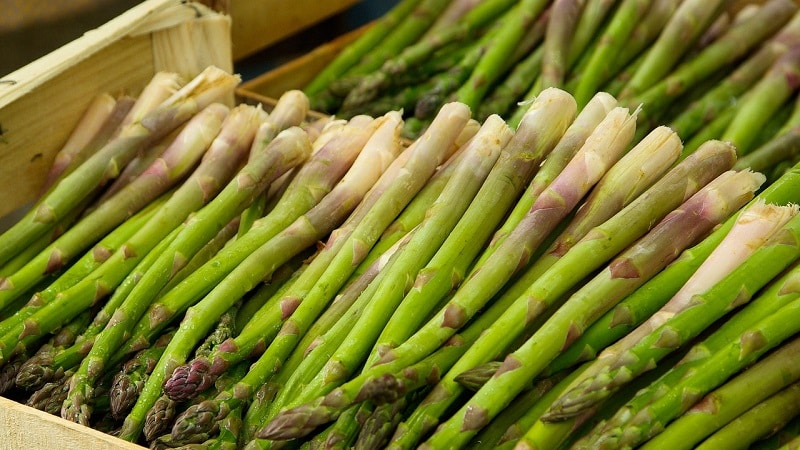
How it grows
First, let's find out where asparagus grows. The crop is actively grown in the USA, Spain, Italy, France, North Africa and Asia. Wild asparagus grows in Siberia. Initially, white shoots emerge from the rhizomes, which acquire a green or purple hue as they grow.
These stems later grow into bushes up to 1.5 m high with fluffy green branches and red berries. You've probably seen asparagus in flower bouquets. The life cycle of the plant is 20 years. During this period, it produces about 50 shoots.
Application
Asparagus is used in cooking. Thanks to its excellent taste, the product is included in the menu of restaurants all over the world. In France and Italy they even organize Asparagus Days and prepare all sorts of dishes from the vegetable.
The healing properties and chemical composition of the product allow it to be used for medicinal and preventive purposes.
In cooking
White and green asparagus are most often used for cooking. The purple stems have a bitter taste that not everyone likes.
Young fresh shoots with a dense top, without signs of wilting and dryness, are suitable for food. To preserve the taste and beneficial properties, the product is subjected to short heat treatment. It is enough to soak the stems in boiling water for a few minutes or steam them. Green asparagus is blanched for 3-8 minutes, white - 10-15 minutes.
The vegetable is eaten as an independent dish with various sauces. The traditional way to serve asparagus is with white hollandaise sauce. The product is added to salads, soups, closed and open pies, used as a side dish for meat, and baked on the grill with bacon.
To prepare Hollandaise sauce you will need:
- egg yolks – 4 pcs.;
- lemon juice – 1 tbsp. l.;
- butter 82% – 125 g;
- a pinch of salt;
- cream 20% – 2 tbsp. l.
Mix the yolks with lemon juice in a saucepan and place in a water bath. The water should not boil, otherwise the yolks will curdle. Mash the mixture with a wooden spoon. Divide the butter into parts and add one piece at a time. Stir until completely dissolved. At the end of cooking, pour in the cream, add salt and remove from heat.
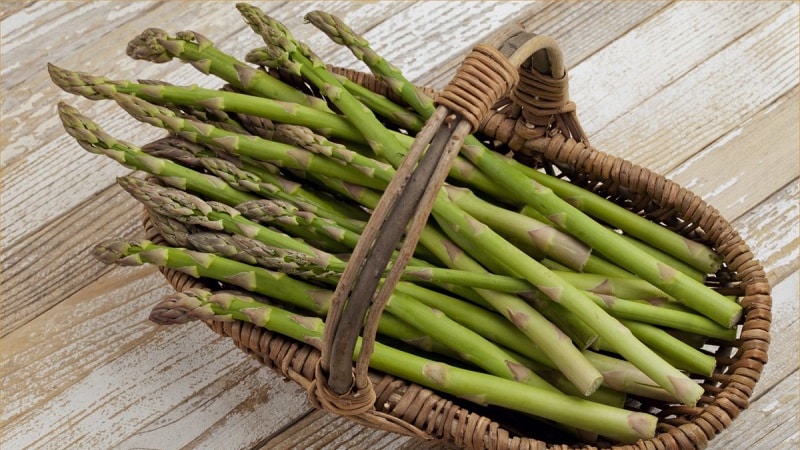
In folk medicine
Asparagus roots are used in folk healing. Tinctures and decoctions are prepared from them to treat diseases:
- genitourinary system (urinary retention, nephritis, pyelonephritis, kidney stones);
- musculoskeletal system (rheumatism, arthritis);
- cardiovascular system (varicose veins, tachycardia);
- endocrine system (diabetes mellitus);
- nervous system (epilepsy).
Products based on medicinal asparagus relieve inflammation, soothe, increase potency, and relieve eczema.
Adherents of traditional medicine note the unusual property of asparagus: medicines made from it do not affect healthy people, but they quickly help sick people.
Read also:
Why pepper leaves curl and what to do about it.
The “French bunch” tomato, ideal for pickling: review and care nuances.
Conclusion
Asparagus is a dietary vegetable with beneficial properties and wonderful taste. It is used in cooking as an addition to pasta, rice, meat and fish. The stems are grilled, boiled in water or steamed.
The healing properties of the product make it possible to prepare homemade medicines based on it to get rid of diseases of the heart, blood vessels, stomach, muscles and bones.